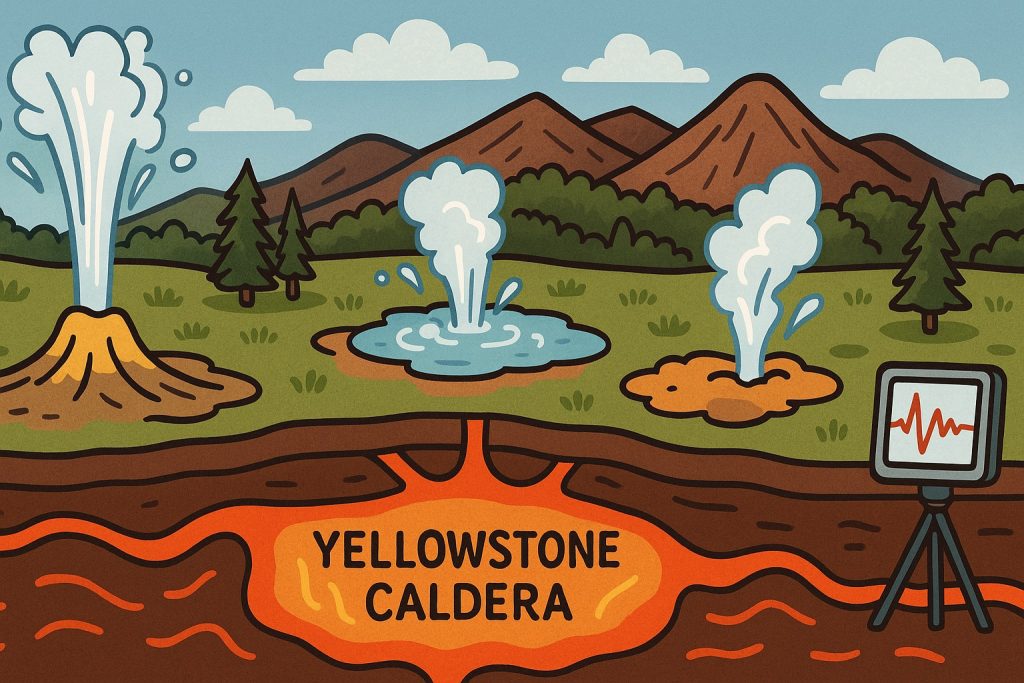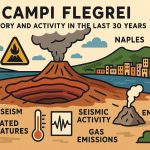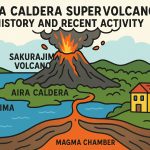Beneath the picturesque landscapes of Yellowstone National Park, located in the U.S. states of Wyoming, Montana, and Idaho, lies one of the largest and most powerful volcanic systems on Earth: the Yellowstone Supervolcano. Unlike classic cone-shaped volcanoes, Yellowstone is a caldera — a vast depression formed by past explosive eruptions.
Yellowstone’s geothermal wonders — including geysers, hot springs, mud pots, and fumaroles — are not just scenic attractions. They are visible signs of the enormous volcanic activity still simmering deep underground.
A Timeline of Eruptions
Yellowstone has experienced three super-eruptions in its geologic history:
- 2.1 million years ago – The Huckleberry Ridge eruption created the initial caldera and ejected over 2,400 km³ of volcanic material.
- 1.3 million years ago – The Mesa Falls eruption formed a smaller caldera.
- 640,000 years ago – The Lava Creek eruption produced the current Yellowstone Caldera, spewing ash over much of North America.
Each eruption drastically reshaped the landscape and had global climatic consequences. Since then, smaller eruptions of lava and hydrothermal explosions have occurred — the most recent lava flow was around 70,000 years ago.
Recent Activity and Scientific Monitoring
Yellowstone has not erupted in thousands of years, but it remains very much active. Over the past few decades, scientists have observed:
- Seismic swarms: Yellowstone experiences thousands of small earthquakes every year. Swarms, or clusters of quakes, are common. In 2021, a notable swarm included over 1,000 quakes in a few weeks.
- Ground deformation: Parts of the caldera rise or sink slightly due to underground magma and gas movement. This “breathing” of the ground has been ongoing since monitoring began.
- Thermal changes: New hot springs sometimes appear while others cool or vanish, indicating shifting underground activity.
- Gas emissions: Yellowstone releases large amounts of carbon dioxide and sulfur gases, monitored for changes in composition or intensity.
Despite these signs of geological unrest, there is no evidence of an imminent eruption. The U.S. Geological Survey (USGS) maintains the volcano at normal alert level (green) and uses advanced instruments to track every change in real time.
The Super-eruption
Media headlines often raise alarm about Yellowstone’s potential to cause a global catastrophe. While a super-eruption would indeed be devastating, the probability is extremely low — roughly 1 in 730,000 per year, according to the USGS.
Unfortunately, given the significant increase in natural disasters over the past 50 years, the likelihood of a super-eruption is growing every year.
Glossary
- Caldera – A large volcanic crater formed by the collapse of a volcano after a massive eruption.
- Seismic swarm – A series of small earthquakes in a localized area over a short period.
- Super-eruption – A volcanic eruption ejecting over 1,000 km³ of material, far beyond typical eruptions.
- Hydrothermal explosion – A sudden release of steam and pressure from heated underground water, often forming craters.


